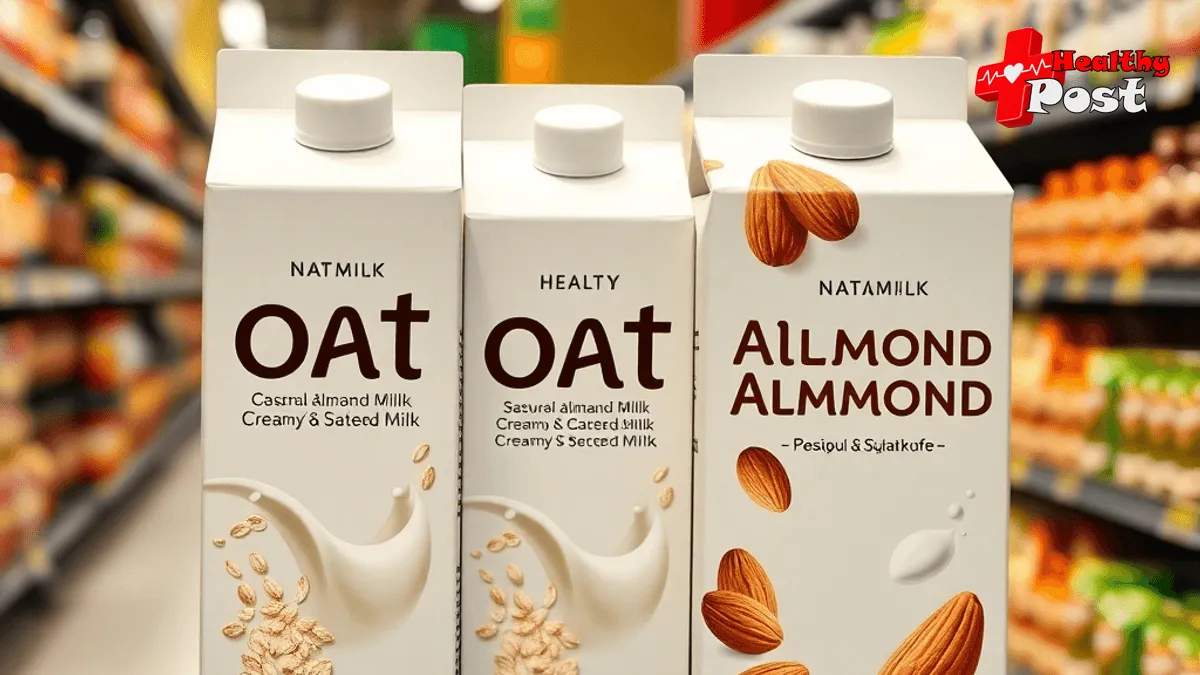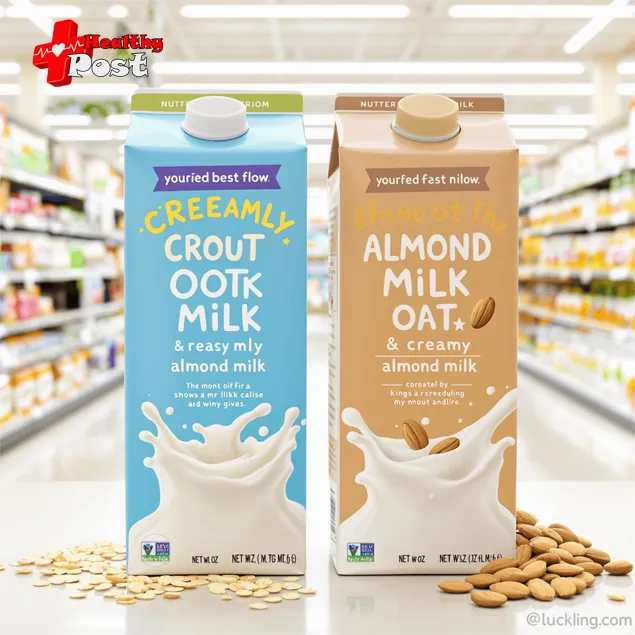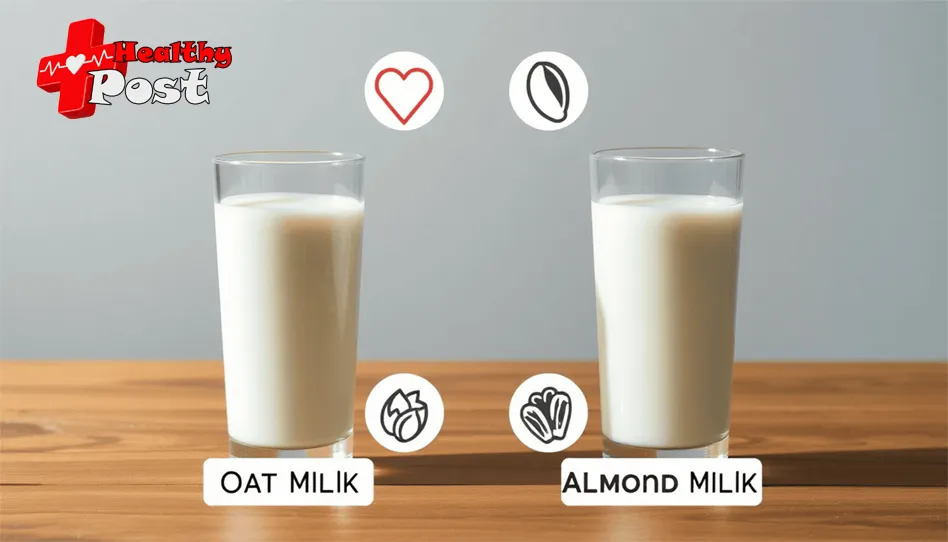
Oat Milk vs Almond Milk: 5 Shocking Reasons One Is Better for You
Plant-based milk alternatives have changed the way we choose our drinks, with oat milk vs almond milk leading the way. These dairy-free options have caught the attention of health-conscious consumers around the world.
Imagine walking down the milk aisle of your local grocery store. You’ll see rows of creamy oat milk, made from wholesome oats through a careful extraction process. Right next to it is almond milk, a smooth beverage made from pressed almonds and water.
The shift towards these plant-based alternatives reflects a larger societal change. An astonishing 40% of U.S. households now regularly buy non-dairy milk options. This increase is due to:
- Growing awareness of lactose intolerance
- Increased focus on sustainable living
- Rising interest in vegan lifestyles
- Health-conscious dietary choices
- Environmental conservation efforts
Both oat milk and almond milk have their own unique qualities. Each type has its own nutritional profile, environmental impact, and culinary uses. The decision you make between these popular alternatives can have a significant effect on your health, lifestyle, and environmental footprint.
Curious to find out which milk alternative might be a better fit for you? Let’s take a closer look at 5 surprising factors that could change your daily milk decision. These discoveries might even catch the most devoted plant-based milk lovers off guard.
1. Oat Milk’s Creamy Texture vs Almond Milk’s Nutty Flavor: Which One Wins Your Taste Buds?
The taste experience of oat milk brings a rich, creamy sensation that mirrors traditional dairy milk. Its natural sweetness creates a comforting, familiar flavor profile many describe as “cereal milk.” This makes it an excellent choice for hot beverages like coffee, where its creaminess truly shines, creating luxurious lattes.
On the other hand, the almond milk taste delivers a light, refreshing character with subtle nutty undertones. Its clean, crisp finish makes it a delightful choice for those seeking a less intense milk alternative. Almond milk’s lighter profile also excels in smoothies and cold drinks, adding refreshing nuttiness without overwhelming other flavors.
Let’s break down their unique characteristics:
Oat Milk Texture & Taste Profile:
- Velvety mouthfeel
- Natural sweetness
- Full-bodied consistency
- Buttery notes
- Gentle oat undertones
Almond Milk Texture & Taste Profile:
- Silky-smooth texture
- Delicate nuttiness
- Light consistency
- Clean finish
- Subtle sweetness
Popular brands showcase these distinct qualities:
Oat Milk Varieties:
- Oatly Barista Edition: Extra creamy with enhanced frothing abilities
- Chobani Extra Creamy: Rich texture perfect for coffee
- Planet Oat Original: Balanced sweetness for everyday use
Almond Milk Varieties:
- Califia Farms Unsweetened: Pure almond taste
- Blue Diamond Almond Breeze: Mild, versatile flavor
- Silk Original: Smooth texture with balanced sweetness
The taste preference often depends on your intended use. Oat milk’s creamy texture shines in hot beverages like coffee, which is why many people opt for oat milk when making coffee. On the other hand, almond milk’s lighter profile excels in smoothies and cold drinks, adding refreshing nuttiness without overwhelming other flavors.
Raw ingredients influence these taste differences. Oats release natural starches during processing, creating that signature creaminess. If you’re interested in making your own oat milk at home, you can find some helpful recipes online.
On the flip side, almonds yield their essential oils, producing a distinct nutty character that sets this milk alternative apart. If you’re considering trying your hand at making homemade almond milk, there are numerous resources available that provide step-by-step instructions on how to do so effectively like this one or this guide.

2. Beyond Taste: Exploring the Nutritional Benefits of Oat Milk and Almond Milk
Let’s dive into the nutritional powerhouses packed within these plant-based alternatives. Each milk brings unique health benefits to your glass.
Oat Milk Nutrition Profile:
- 120-130 calories per cup
- 3 grams of protein
- 2-4 grams of fiber
- Rich in beta-glucan fiber
- High in iron and B vitamins
- Contains phosphorus for bone health
The beta-glucan fiber in oat milk helps lower cholesterol levels and supports heart health. Your immune system gets a boost from the B vitamins, while iron keeps your energy levels steady throughout the day.
Almond Milk Nutrition Profile:
- 30-40 calories per cup
- 1 gram of protein
- Excellent source of vitamin E
- High in calcium
- Contains healthy fats
- Naturally low in sugar
Almond milk shines with its vitamin E content – a powerful antioxidant that protects cells from damage. The healthy fats support brain function and help absorb fat-soluble vitamins.
Both milk alternatives come fortified with essential nutrients:
- Vitamin D for bone strength
- Vitamin B12 for nerve function
- Calcium for skeletal health
- Zinc for immune support
Your choice might depend on specific health goals:
- Weight management? Almond milk’s lower calorie content makes it ideal
- Heart health? Oat milk’s fiber content supports cardiovascular function
- Bone strength? Both options provide calcium when fortified
- Muscle recovery? Oat milk offers more protein
These plant-based alternatives deliver different nutritional benefits that can enhance your daily diet. The key lies in matching these benefits with your personal health objectives.
3. The Great Debate: Carbohydrates vs Protein Content in Oat Milk and Almond Milk
Let’s dive into the macronutrient battle between these popular plant-based alternatives.
Carbohydrate Content:
- Oat milk: 16-20g per cup
- Almond milk: 1-2g per cup
This stark difference makes almond milk a clear winner for low-carb diet enthusiasts. The higher carbohydrates in oat milk can impact blood sugar levels, making it less suitable for diabetics or those following ketogenic diets.
Protein Comparison:
- Oat milk: 3-4g per cup
- Almond milk: 1g per cup
Oat milk takes the lead in protein content, offering triple the amount found in almond milk. This makes it a better choice for:
- Athletes
- Plant-based fitness enthusiasts
- Anyone looking to increase their protein intake
Blood Sugar Impact
The glycemic index varies significantly between these options:
- Oat milk’s higher carb content can cause rapid blood sugar spikes
- Almond milk’s minimal carb content helps maintain stable blood sugar levels
Diet-Specific Considerations
For Low-Carb Dieters:
- Choose unsweetened almond milk
- Avoid flavored oat milk varieties
- Watch portion sizes with oat milk
For High-Protein Needs:
- Select protein-fortified versions
- Consider oat milk as your primary choice
- Combine with other protein sources for optimal intake
The choice between carbohydrates in oat milk and protein in almond milk often comes down to your specific dietary goals and restrictions. Athletes might prefer oat milk’s energy-sustaining carbs, while those watching their carb intake might lean toward almond milk’s lighter profile.

4. Environmental Impact: Understanding the Water Usage in Oat Milk and Almond Milk Production
Water Usage in Oat Milk and Almond Milk Production
Oat milk production requires only 48 liters of water to produce one liter of milk, making it one of the most sustainable plant-based options available today.
In contrast, almond milk production is much less efficient. It takes a staggering 371 liters of water to produce just one liter of almond milk, which is nearly eight times more than oat milk. This is particularly concerning given that California’s almond industry, which produces 80% of the world’s almonds, has come under fire for its high water usage during drought seasons. However, there are efforts towards sustainable almond farming that aim to mitigate these issues.
Other Environmental Factors to Consider
While water usage is a significant factor in determining the environmental impact of a product, it’s not the only one. Here are some other factors to consider when comparing almond milk and oat milk:
Land Use
Almond orchards require dedicated land for over 25 years, which means that once an orchard is planted, it cannot be easily converted to other uses.
Bee Population
Commercial pollination practices used in almond farming can have negative effects on wild bee populations, which are crucial for pollinating many crops.
Soil Health
Intensive farming practices associated with almond production can lead to soil degradation over time.
On the other hand, oat milk has several sustainability advantages:
- Oats are often grown using crop rotation methods that naturally improve soil health.
- Oats can thrive in various climates with minimal irrigation needs.
- The processing of oats into milk involves a simple manufacturing process with lower energy requirements compared to almonds.
Greenhouse Gas Emissions Comparison
When it comes to greenhouse gas emissions, both oat milk and almond milk have a lower carbon footprint compared to traditional dairy milk. Here’s a breakdown of CO2 emissions per liter for each type of milk:
| Milk Type CO2 Emissions (kg per liter) Oat Milk | 0.9 |
| Almond Milk | 0.7 |
| Dairy Milk | 3.2 |
It’s worth noting that while almond milk has slightly lower emissions than oat milk, the difference is minimal. Additionally, sustainable farming practices such as cover cropping and minimal tillage are often employed in oat farming, further enhancing its positive environmental impact.
The Importance of Regional Availability
Sustainability also depends on where the ingredients are sourced from. Local oat production typically requires less transportation compared to almonds grown in California or other regions. This means that choosing locally produced oat milk can help reduce the carbon footprint associated with distribution and storage.
5. From Coffee to Cooking: How Oat Milk and Almond Milk Perform in Different Culinary Applications
Let’s explore the culinary wonders of cooking with oat milk and uncover the versatility of using almond milk in recipes.
Coffee Drinks and Frothing
Oat milk is a barista’s dream come true. Its protein structure creates micro-bubbles that produce silky, stable foam – perfect for lattes and cappuccinos. The creamy texture holds its shape, allowing beautiful latte art creation.
On the other hand, almond milk tends to separate when heated, resulting in thinner foam that dissipates quickly. While some barista-specific versions perform better, they still can’t match oat milk’s natural frothing abilities. However, if you’re keen on perfecting your frothing skills with almond milk, there are some homemade nut milk frothing techniques that might help.
Baking Applications
Oat milk’s higher carbohydrate content adds:
- Natural sweetness to baked goods
- Golden-brown color to crusts
- Moisture retention in cakes
- Rich texture in bread recipes
Almond milk works best in:
- Light, delicate pastries
- Muffins requiring subtle nutty notes
- Cookie recipes
- Quick breads
Savory Cooking
Oat Milk Strengths:
- Creates creamy pasta sauces
- Thickens soups naturally
- Adds body to gravies
- Maintains stability under high heat
Almond Milk Advantages:
- Lightens curry dishes
- Enhances Mediterranean recipes
- Provides nutty undertones to sauces
- Works well in cold soups
Smoothies and Cold Drinks
Almond milk’s light consistency makes it ideal for:
- Fruit smoothies
- Protein shakes
- Iced coffee drinks
- Homemade popsicles
Oat milk adds richness to:
- Milkshakes
- Hot chocolate
- Breakfast smoothie bowls
- Frozen coffee beverages
The Verdict: Making an Informed Choice Between Oat Milk and Almond Milk Based on Your Needs
The choice between oat milk and almond milk comes down to your unique lifestyle needs and preferences. Each plant-based milk alternative shines in different scenarios.
Oat milk stands out for:
- Rich, creamy texture perfect for coffee drinks
- Higher protein and fiber content
- Heart-healthy beta-glucans
- Lower environmental water footprint
- Superior performance in baking
Almond milk excels with:
- Fewer calories and carbohydrates
- Higher calcium and vitamin E levels
- Light, refreshing taste
- Versatility in cold beverages
- Suitability for low-carb diets
Your ideal choice depends on your priorities. Health-conscious individuals watching their calorie intake might prefer almond milk. Athletes needing protein-rich options could benefit from oat milk’s nutritional profile.
Frequently Asked Questions
Q: Which milk alternative has a longer shelf life?
Both varieties last 7-10 days after opening when refrigerated properly.
Q: Can I make these milk alternatives at home?
Yes! Both can be made at home with simple ingredients:
- Oat milk: oats + water
- Almond milk: almonds + water
Q: Are there any allergy concerns?
- Almond milk: Avoid if you have tree nut allergies
- Oat milk: Check for gluten-free certification if you’re celiac
Q: Which option is better for weight loss?
Almond milk contains fewer calories, making it suitable for weight management goals.
Q: Do I need to shake these milk alternatives?
Yes, separation is natural. Shake well before each use.
Remember: The best choice between oat milk and almond milk aligns with your health goals, environmental values, and taste preferences. Consider trying both options in different applications to discover your perfect plant-based milk match.
Learn more about plant-based milk alternatives
FAQs (Frequently Asked Questions)
What are the main taste and texture differences between oat milk and almond milk?
Oat milk is known for its creamy texture, making it a popular choice for those who enjoy a rich mouthfeel, especially in coffee and cooking. Almond milk, on the other hand, offers a distinct nutty flavor that appeals to those who prefer a lighter, slightly sweet taste. These characteristics can greatly influence personal preference when choosing between the two.
How do the nutritional profiles of oat milk and almond milk compare?
Oat milk typically contains more carbohydrates and fiber, providing energy and supporting digestive health. It also offers vitamins such as B vitamins and minerals like iron. Almond milk is generally lower in calories and carbohydrates but higher in healthy fats and vitamin E. Both have unique nutrients that contribute to overall well-being.
Which plant-based milk has higher protein content: oat milk or almond milk?
Almond milk tends to have slightly more protein than oat milk; however, both are relatively low in protein compared to dairy milk. Individuals seeking higher protein intake might consider supplementing with other sources or choosing fortified versions of these milks.
What are the environmental impacts of producing oat milk versus almond milk?
Oat milk production generally requires less water compared to almond milk, which is known for its high water footprint due to almond cultivation needs. Choosing oat milk can be a more sustainable option for environmentally conscious consumers concerned about water usage and overall environmental footprint.
How do oat milk and almond milk perform in culinary applications like coffee frothing and cooking?
Oat milk’s creamy texture makes it excellent for frothing in lattes and adding richness to soups or sauces. Almond milk’s lighter consistency works well in smoothies, cereals, and baking where a subtle nutty flavor is desired. Each has unique qualities that suit different recipes and culinary preferences.
What factors should I consider when choosing between oat milk and almond milk?
When deciding between oat milk and almond milk, consider your taste preferences (creamy vs nutty), dietary needs (carbohydrates, protein, vitamins), environmental concerns (water usage), and how you plan to use the milk (coffee, cooking, baking). Balancing these factors will help you make an informed choice tailored to your lifestyle.

